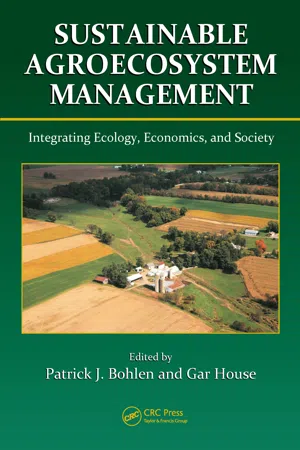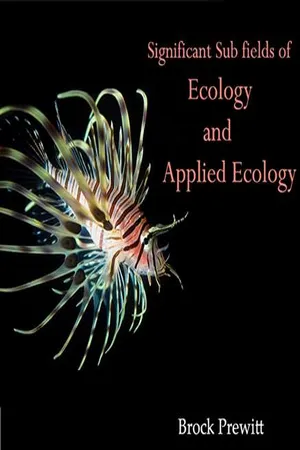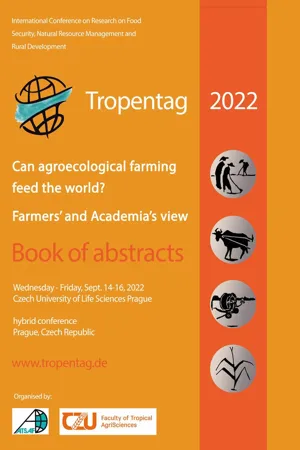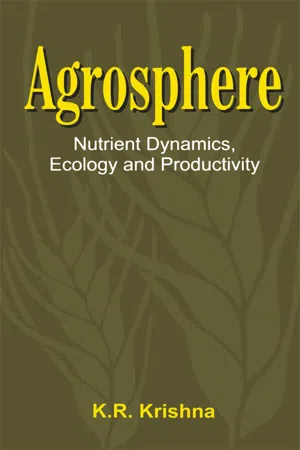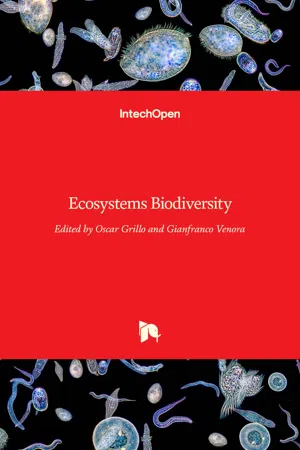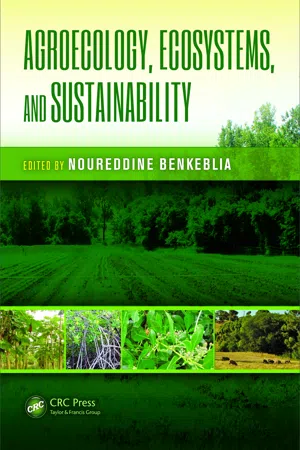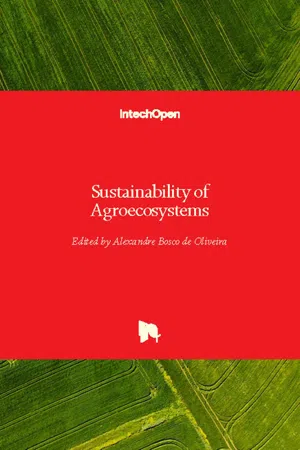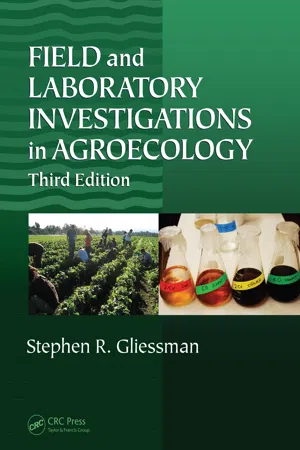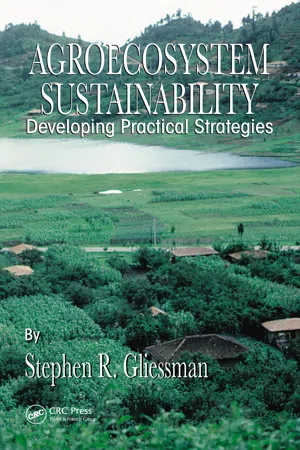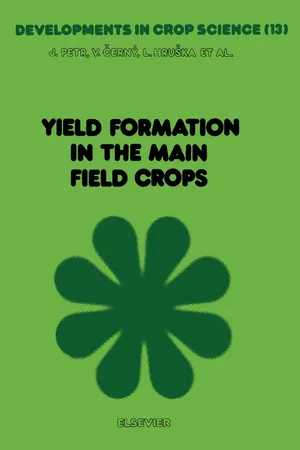Geography
Agroecosystems
Agroecosystems are agricultural systems that encompass the interaction between crops, livestock, and the environment. They involve the management of natural resources, such as soil and water, and the integration of ecological principles into agricultural practices. Agroecosystems aim to optimize productivity while minimizing negative environmental impacts, promoting sustainable and resilient food production systems.
Written by Perlego with AI-assistance
Related key terms
1 of 5
12 Key excerpts on "Agroecosystems"
- eBook - PDF
Sustainable Agroecosystem Management
Integrating Ecology, Economics, and Society
- Patrick J. Bohlen, Gar House, Patrick J. Bohlen, Gar House(Authors)
- 2009(Publication Date)
- CRC Press(Publisher)
Solutions offered throughout this book rely on using the ecosystem concept as a unifying solution framework. 1.3 THE EMERGENCE OF AGROECOLOGY AND THE AGROECOSYSTEM CONCEPT Agroecology is the integrative study of the interactions among biological, environmental, and management factors in agricultural systems. It has been variously defined as (1) the application of ecological science to the design and management of sustainable Agroecosystems, (2) a holistic approach to agriculture, drawing from traditional, alternative, and local, small-scale systems, and (3) an approach that links the ecological and socioeconomic factors to develop agroeco-systems that sustain agricultural production, farming communities, and environmental health (Gliessman 1998). Agroecology emerged as a field of study in the 1980s and includes diverse perspectives and various attempts to develop unified concepts and approaches (Lowrance et al. 1984; Altieri 1987; Coleman and Hendrix 1988; Gliessman 1998; Robertson and Paul 1998; Rickerl and Francis 2004a). The field of agroecology is fundamentally an application of the ecosystem concept within a social science framework. Early developments in agroecosystem ecology drew heavily from ecosystem ecology, which emerged as a discipline in middle of the twentieth century (Odum 1959). Ecosystem ecology emphasizes the links between organisms and their physical environment, and the flow of energy and materials through such linked biophysical systems (Chapin et al. 2002). Consequently, early attempts to unify concepts of agroecosystem ecology focused mainly on the biophysical inter-actions in Agroecosystems (Lowrance et al. 1984). However, ecological and social scientists have long recognized the importance of social and economic factors in Agroecosystems and have debated whether Agroecosystems are essentially ecological systems with a strong social component or fun-damentally socioeconomic systems with a strong ecological component (Lowrance et al. 1984). - No longer available |Learn more
- (Author)
- 2014(Publication Date)
- University Publications(Publisher)
A more common definition of the word can be taken from Dalgaard et al., who refer to agroecology as the study of the interactions between plants, animals, humans and the environment within agricultural systems. Consequently, agroecology is inherently multidisciplinary, including factors from agronomy, ecology, sociology and economics . In this case, the “-ecology” portion of agroecology is defined broadly to include social, cultural, and economic contexts as well. Agroecology is also defined differently according to geographic location. In the global south, the term often carries overtly political connotations. Such political definitions of the term usually ascribe to it the goals of social and economic justice; special attention, in ________________________ WORLD TECHNOLOGIES ________________________ this case, is often paid to the traditional farming knowledge of indigenous populations . North American and European uses of the term sometimes avoid the inclusion of such overtly political goals. In these cases, agroecology is seen more strictly as a scientific discipline with less specific social goals. Fred Buttel makes a more academic distinction of the various approaches within the field, separating it into five broad categories: Ecosystems agroecology This approach is driven by the ecosystems biology of Eugene Odum. This approach is based in the hypotheses that the natural systems, with its stability and resilience, provide the best model to mimic if sustainability is the goal. Normally, ecosystems agroecology is not actively involved in social science; however, this school is essentially based on the belief that large-scale agriculture is inappropriate. The work of Steve Gliessman is prototypical of this approach. Agronomic ecology The basic approach in this branch is derived mostly from agronomy, including the traditional agricultural production sciences. - eBook - PDF
Green Food
An A-to-Z Guide
- Dustin Mulvaney, Dustin R. Mulvaney(Authors)
- 2010(Publication Date)
- SAGE Publications, Inc(Publisher)
J. Anthony Abbott Stetson University A GROECOLOGY Agroecology is the study of agriculture through an ecological lens; that is, by treating agricultural systems as ecosystems managed by humans for food, fiber, and fuel produc-tion. Ecosystems have both biotic and abiotic components: They are composed both of organisms and the elements of the environment in which they live. Agroecosystems include organisms such as crop plants, livestock, weeds, vertebrate and invertebrate pests, bacteria, viruses, and fungi, as well as inorganic components such as water, minerals, air, light, energy, and the nonliving soil matrix. Each agroecosystem also has a specific geo-graphical, economic, and social context; that is, it is located in a particular landscape, economy, and set of communities ranging from local to global. To underscore the impor-tance of these nonagronomic features and the breadth of scope, some agroecologists define their field as the ecology of the food system. The field of agroecology stems from the disciplines of ecology and agronomy. It is similar to other types of applied ecology, such as restoration ecology, in its work to use ecological principles to improve managed ecosystems, as well as to use managed ecosys-tems as experimental sites to test ecological principles. This focus on application may make it seem to closely resemble its agronomic roots; however, agroecology differs from agron-omy in at least two ways. First, it more purposefully includes the human component of Agroecosystems, reaching across disciplinary boundaries to include sociological, anthropo-logical, and economic analysis of agricultural problems and potential solutions. Second, where agronomy tends toward reductionism, agroecology approaches farming systems from a holistic perspective. - eBook - PDF
Tropentag 2022 – International Research on Food Security, Natural Resource Management and Rural Development
Can agroecological farming feed the world? Farmers' and academia's views
- Tielkes, Eric(Authors)
- 2022(Publication Date)
- Cuvillier Verlag(Publisher)
As a dynamic con- cept that encompasses a scientific discipline, an array of sustainable agricul- tural practices and a social movement, agroecology embraces a set of uni- versal principles, yet agroecological designs rely on context-specific knowl- edge and tailored practices that are oriented at offering contextually sensitive solutions. This flexibility challenges the robustness, contextual validity and comparability of the generic sustainability indicators with which agroecol- ogy’s performance is currently being measured and captured in the global evidence base that informs decision-makers. The gap between generic scien- tific knowledge and local knowledge in agroecology calls for a holistic, par- ticipatory and inclusive approach to producing evidence that integrates con- textualized science and local (including indigenous) knowledge of all rele- vant food system actors (FSAs). As part of its 2030 research and innovation strategy, OneCGIAR and partners have started a new science-for-innovation initiative in agroecology that attempts at narrowing this gap by facilitating transdisciplinary interactions between researchers, small-scale farmers and other FSAs beyond the farm (e.g., extension services, NGOs, private sector, policymakers, funders and investors) in seven low-income countries, namely Burkina Faso, India, Kenya, Laos PDR, Peru, Tunisia and Zimbabwe. The ini- tiative “Transformational Agroecology across food, land, and water systems” (AE-I) will, at its core, establish an international network of Agroecological Living Labs (ALLs) that will explore either of following three transition path- ways, namely (i) agroecologically “intensifying” farming systems that cur- rently exhibit low productivity due to low input use; (ii) “redesigning” small- scale farming with high external input use; and (iii) “converting” profitable medium-scale enterprises with high external input use. - eBook - PDF
Agrosphere
Nutrient Dynamics, Ecology and Productivity
- K R Krishna(Author)
- 2003(Publication Date)
- CRC Press(Publisher)
It practi cally intrudes into any part of the globe that is congenial, and supports cropping systems. The basic ingredients that allow the development of agrosphere in these latitudes are fertile soils, well adopted crop genetic stocks, water and suitable environmental parameters. On a broader 2 Agrosphere: Nutrient Dynamics, Economics and Productivity horizon, agrosphere may be defined as a man-made conglomerate of Agroecosystems that occurs world-wide and is integrated through constant interaction with other ecospheres namely lithosphere (soils), hydrosphere, atmosphere and biosphere. The evolution of agrosphere is synonymous with the natural history of agriculture, spread of cultivable land, agrarian revolutions and improved farming practices. Indeed, as the seeds for primordial agriculture were sown in the 'Fertile Crescent' and agrosphere took roots, perhaps there was no inkling of the vast influence that mankind had initiated on the naturally evolved biosphere of this earth. At present, the agrosphere as defined above comprises a series of cropping ecosystems (Pearson, 1992). For example, the rice agroecosystem in Asia, temperate wheat zone in North America and Europe, the com belt, citrus agroecosystem in Florida, pearl millet in Sahel, coffee in South America etc. These Agroecosystems are unique, and well adopted to the geographic region. There may be several different ways of defining such an agroecosystem. To mention a recent example, Wood et al. (2000) explain agroecosystem as an agricultural and natural resource system managed by humans for the primary purpose of producing food as well as other socially valuable non-food goods. Clearly, these man-made Agroecosystems are dissimilar with natural vegetation, or forests and other biomass classified under biosphere. In order to avoid confounded inferences, ecologists often try to identify this distinction by using prefixes such as 'disturbed' which is different from 'undisturbed' natural ecosystem. - eBook - PDF
- Oscar Grillo, Gianfranco Venora, Oscar Grillo, Gianfranco Venora(Authors)
- 2011(Publication Date)
- IntechOpen(Publisher)
15 Environmental Evaluation and Monitoring of Agro-Ecosystems Biodiversity Fabio Taffetani, Michele Rismondo and Andrea Lancioni Dipartimento di Scienze Agrarie, Alimentari e Ambientali (3A) Università Politecnica delle Marche Via Brecce Bianche, Ancona Italy 1. Introduction Agroecosystems are open systems, whereby continual human intervention is needed for the maintenance of an equilibrium created by man himself with the aim of maximising the production provided by a few domesticated plant and animal species. In these systems, the equilibrium is maintained through energy input from outside that makes the operations possible, which are designed to create optimal conditions for the growth of the cultivated plants and the animals raised. The individual agricultural systems can be very different depending on the pedoclimatic characteristics of the territories, the types of cultivation practiced, and the intensive practices used, although in all cases, to maintain specific productive characteristics there is the need for human intervention. If they are abandoned to their natural evolution, these systems tend to recover their natural state, with increases in the areas occupied by spontaneous vegetation and with substantial changes in the population dynamics of the various species that make up the wild fauna, obviously at the expense of the species that benefit from the human actions. Despite being characterised by a specific level of structural simplicity and by a decrease in their natural state that is caused by the modifications to the original environment that had the aim of obtaining animal and plant production for mainly food and energy uses, these Agroecosystems cover a large part of the Community area. For this reason, the conservation of the biodiversity on a large scale needs interventions that are aimed at the preservation of the contexts that are most hard hit by human activities. - eBook - PDF
- Noureddine Benkeblia(Author)
- 2014(Publication Date)
- CRC Press(Publisher)
195 FOOD SYSTEM APPROACH IN AGROECOLOGY favoring control of pests and maladies with biological control, and to redesign Agroecosystems based on ecosystem services and adapted to social and environmental conditions specific to each territory. The required interdisciplinarity for agroecology research needs, therefore, an evolution in the way to design programs and research objects. As shown with the third research example, there exist disjunctions between the ecological and agronomic functional areas (a drinking water catchment and farmers’ fields), the management area (the farm territory, the collecting area for an agricultural commodity, or even the territory of a local interest group of actors), and the areas used by the citizens. It is, therefore, necessary to establish coherence and a common perspective for the varied knowledge of different origins that concerns the objectives, the sectors, and the different scales. Ecology and agronomy, historically the basic disciplines of agroecology, contribute to a holistic approach with their capacity to analyze changes of farmers’ practices and their production and envi-ronmental consequences, as well as applying the concepts and methods of ecology for food chain analyses, such as matter fluxes and transformation, to the evaluation of food systems, something the social sciences are not able to carry out. The social sciences have historically developed and con-tinue to develop theories, concepts, and methods to deal with different issues in agriculture and food systems. The individual in interaction and exchange with other actors is, therefore, at the center of analyses, and increasingly these analyses are carried out in a participatory way. To progress toward a global and systemic vision of agroecology of the food system, therefore, both interdisciplinary and participatory research is needed (Petit et al. 2011). - eBook - PDF
- Alexandre Bosco de Oliveira(Author)
- 2018(Publication Date)
- IntechOpen(Publisher)
Unlike the development of controlled experiments in the field that will surely take much more time and financing. In Figure 2 . The Agroecosystem (AES) is defined as the initial and main link of the Production-Consumption Chains. In the AES the first level of supply of agricultural production is acti-vated (fresh or with added value) and the distribution processes begin to satisfy the estimated demand, the regional, national or international market and therefore consumption. In this apparent and simple process occurs the most important phenomenon of social reproduction: Consumption -to live -inexorably depend on the AES and in that same process the AES also depends on consumption (family and social) to survive. This constitutes what the higher system of the AES may be committed to by its social responsibility: Feeding society. 4. A new agroecology With everything and how valuable Agroecology is, it certainly should not remain static and enclosed in its box forever. The agroecological leaders in the world could perhaps be integrated to new approaches to study the Agroecosystem. One of them is that of complex systems with cybernetics of second order and therefore with researchers at the observer level of those who observe [Researchers who study farmers observing their agricultural processes (Agroecosystem) Figure 2. The agroecosystem in the production-consumption chains. Epistemic and Conceptual Orphanhood in the Sustainability of Agroecosystems http://dx.doi.org/10.5772/intechopen.74110 11 has the great advantage that the observer of second order (the researcher) can observe himself in the same observational process]. Criticism about the biological-ecological approach is by no means new, since 1980 Dr. - Stephen R. Gliessman(Author)
- 2014(Publication Date)
- CRC Press(Publisher)
Section IV Studies of Farm and Field Systems This page intentionally left blank This page intentionally left blank 167 18 Mapping Agroecosystem Biodiversity Background Each agroecosystem has its own unique structure and spatial organization. In a diverse system, the spatial organization of just the biotic components of the system may be exceedingly complex, and understanding it requires that one ask a variety of questions: What species are present? What is each species’ relative abundance? How are the species distributed over space? What is the role of each species in the ecology of the system? What patterns are created by the distribution of species? How do these patterns change over time? The answers to such questions are the basis for a kind of biogeography of the agroecosystem. Biodiversity maps of diverse Agroecosystems are important because they help us understand how diversity is actually manifested and how it might be translated into sustainable function. Textbook Correlation Investigation 17: Agroecosystem Diversity Investigation 21: Landscape Diversity Synopsis An agroecosystem is examined, surveyed, and mapped. The map is used as a basis for recognizing patterns of species distribution and abundance, interspecific relationships, and diversity. It can later be used as a basis for studying ecological relationships, ethnobotany, and farmer decision making about agroecosystem design and management. Objectives • Practice observational skills and improve the ability to recognize and describe spatial patterns. • Learn basic techniques of mapping an agroecosystem. • Learn the taxonomy of species, both crop and noncrop, in an agroecosystem. • Analyze patterns of species abundance, species distribution, patchiness, and spatial variation. • Analyze patterns of interspecific relationships. Investigation 168 Field and Laboratory Investigations in Agroecology Procedure Summary and Timeline Prior to week 1 • Select the agroecosystem(s) to be mapped.- eBook - PDF
Agroecosystem Sustainability
Developing Practical Strategies
- Stephen R. Gliessman(Author)
- 2000(Publication Date)
- CRC Press(Publisher)
Such a broadly applicable definition still begs many other questions: How do we identify an actually existing agroecosystem as sustainable or * This chapter is adapted from Chapter 20 of Agroecology: Ecological Processes in Sustainable Agriculture , by Stephen Gliessman, CRC Press LLC, Boca Raton, FL, 2000. 4 AGROECOSYSTEM SUSTAINABILITY: DEVELOPING PRACTICAL STRATEGIES not? What particular facets of a system make it sustainable or unsustainable? How can we build a sustainable system in a particular bioregion, given realistic economic constraints? Generating the knowledge and expertise for answering these kinds of questions is one of the main tasks facing the science of agroecology today. Ultimately, sustainability is a test of time; an agroecosystem that has continued to be productive for a long period of time without degrading its resource base — either locally or elsewhere — can be said to be sustainable. What constitutes a long period of time? How is it determined if degradation of resources has occurred? How can a sustainable system be designed when the proof of its sustainability remains always in the future? Despite these challenges, we need to determine what sustainability entails. In short, the task is to identify parameters of sustainability — specific characteristics of Agroecosystems that play key parts in agroecosystem function — and to determine at what level or condition these parameters must be maintained for sustainable function to occur. Through this process, we can identify what we will call indicators of sustainability — agroecosystem-specific conditions necessary for and indicative of sustainability. - eBook - PDF
- V. Cerný, L. Hruška, J. Petr(Authors)
- 2012(Publication Date)
- Elsevier Science(Publisher)
FIELD CULTURES AS ECOLOGICAL SYSTEMS Field cultures intended for the production of plant matter utilizable by man depend on their environment, and this in turn is affected by the type of management applied to it. Field cultures can therefore be considered as ecological systems (ecosystems) where man is not only one of the main driving forces, but also an essential component. Man utilizes field cultures by removing a major part of the energy which plants ac cumulate by photosynthesis. This energy, after harvest, is redirected to places where it will be used. An important feature of cultivated crops is that their economic yield con stitutes an important proportion of their total biomass as compared with the yield of natural terrestrial ecosystems (116). For practical purposes it is useful to consider each field culture as a subsystem of a larger agricultural system, i.e. of an agroecosystem characterized economically as a pro duction unit (an agricultural enterprise). The following phases can be recognized in the development of Agroecosystems: (a) gathering of food by primitive human societies; (b) extensive cattle raising, mainly dependent on grazing; (c) shifting agriculture, where the cultivation of crops is moved from one site to another and sites are cleared by cutting and burning down the forest; (d) extensive agriculture, using little or no fertilization; (e) mixed agriculture in relatively closed production units, with a balanced plant and animal production, with little need for an external supply of inorganic substances; (f) intensive agricultural production in comparatively open systems, requiring a constant input of energy from outside. The character and structure of agricultural production units have changed with this evolutionary trend. Stands of crops alternating in crop rotations typical of phases (e) and (f), together with meadows and pastures, can be considered as subsystems of agroeco systems providing primary production. - eBook - PDF
Resilience and the Cultural Landscape
Understanding and Managing Change in Human-Shaped Environments
- Tobias Plieninger, Claudia Bieling(Authors)
- 2012(Publication Date)
- Cambridge University Press(Publisher)
The authors also show how farming practices and social regulations are based on local ecological knowledge. The practices and the knowledge sustaining this Figure 6.2. Labour-intensive and highly diversified farming landscape in Iraqw’ar Da/aw, Tanzania. Photo: L. Bo ¨ rjeson. 100 Mats Widgren intensive and low-external-input farming system are all dependent on these social institutions. A recurring problem when talking about a social–ecological system or an agroecosystem is the problem of boundaries. The authors do not address this issue explicitly; therefore, one has to assume that the boundaries of the agro- ecosystem are the same as those of the roughly 185 km 2 large area. While the authors acknowledge that farming in the area is interlinked with the large expansion areas of the Iraqw through networks of exchange and trade, the study remains in its basic approach based on the idea of a localised and isolated system. Rooted in a different approach, Ha ˚ kansson (2004) has emphasised the role of regional exchange networks, fuelled by the ivory and slave trade in the nine- teenth century, as one important factor behind the establishment of intensive agriculture in eastern Africa. Bo ¨ rjeson (2004) is more cautious in arguing for the role of trade and focuses on more localised exchange networks. Based on inter- views with Iraqw people living in Iraqw’ar Da/aw and in a large surrounding area, Loiske (2004) was able to document the existence of such large, institu- tionalised networks of exchange between farmers in Iraqw’ar Da/aw and farm- ers and pastoralists in the Iraqw expansion areas. These networks of exchange, according to Loiske, are instrumental for the survival strategies in Iraqw’ar Da/aw. Exchange serves to even out seasonal differences between different parts of the Iraqw area, and also makes it possible to accumulate wealth in cattle even for farmers in the densely settled areas where grazing land is limited.
Index pages curate the most relevant extracts from our library of academic textbooks. They’ve been created using an in-house natural language model (NLM), each adding context and meaning to key research topics.
